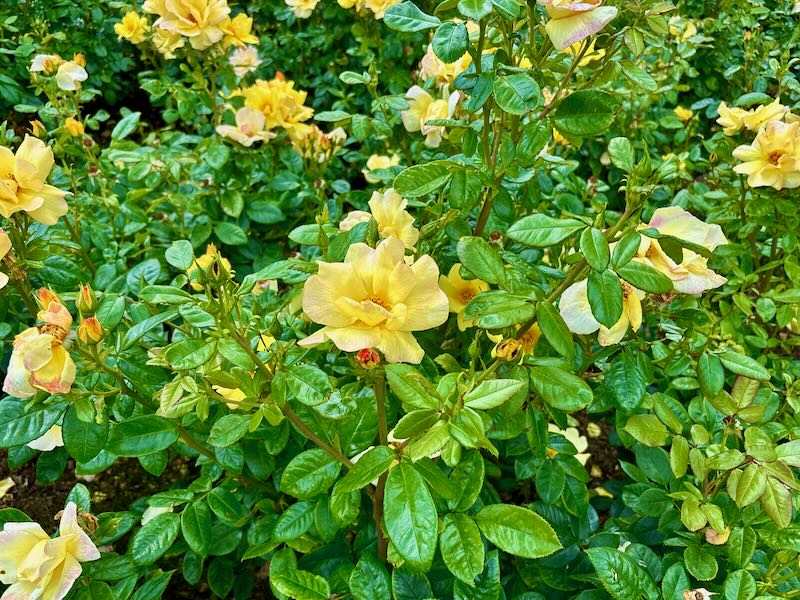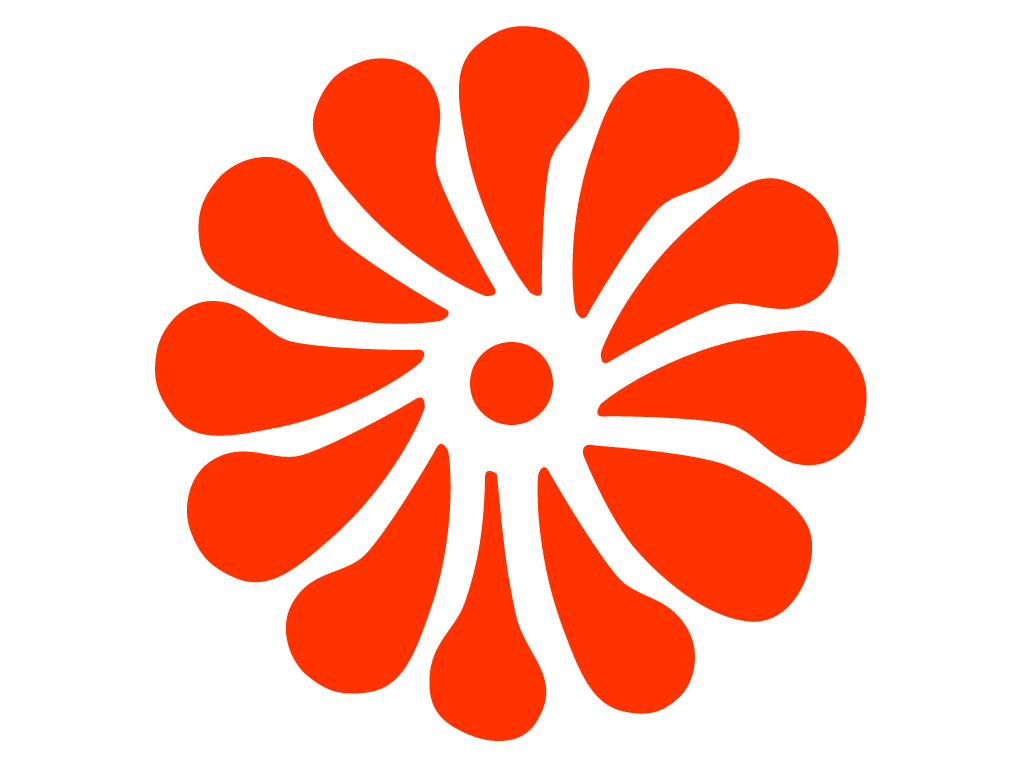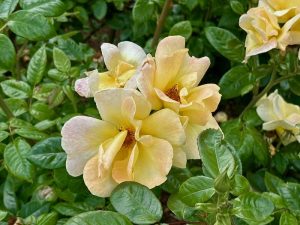Rosa ‘Apple Jack’: A Compact and Cheerful Shrub Rose
Rosa ‘Apple Jack’ or Apple Jack Rose is a compact floribunda shrub that delivers cheerful clusters of single to semi-double yellow blooms with occasional pink shading. Bred by Irish hybridizer David Kenny (breeder code: kenendure) before 2009, this modern selection from the Rosaceae family was made for small spaces and containers. It flowers in repeat flushes, keeps tidy, glossy foliage, and shows strong disease resistance. Plant it for easy, sunny color from late spring until frost.
The origins of Rosa ‘Apple Jack’
This cultivar arose from a purposeful cross: seed parent ‘Baby Love’ and a pollen parent derived from (‘Golden Wedding’ × ‘Bright Smile®’). The goal was clear—combine clean, healthy foliage with nonstop color and a neat habit. The result is a low-maintenance floribunda that fits patios, front borders, and balcony planters as well as traditional beds.
A quick note on names helps shoppers: Rosa ‘Apple Jack’ (two words) is a distinct, yellow floribunda by David Kenny. It is not the cold-hardy Buck rose ‘Applejack’ (one word), which is a larger, pink shrub. Garden centers sometimes blur the two; check the flower color, mature size, and breeder to be sure you’re taking home the plant you want.
Appearance and growth habit
The flowers are bright lemon to soft primrose yellow when they first open. In cool spells you may notice a faint peach or pink wash on the outer petals. Each bloom is single to semi-double, so the golden eye stays visible and draws pollinators. Clusters form at the ends of short stems, creating generous trusses of color rather than lone exhibition blooms. Fragrance is light to none, which keeps the focus on clear color and clean foliage.
Leaves are small, medium green, and semi-glossy. That scale suits the compact framework and gives the plant a polished look even between flushes. Expect a rounded, bushy habit about 45–60 cm tall by 40–45 cm wide (18–24 in × 16–18 in). In rich soil and mild climates it can push a little taller, but it remains a front-of-border rose you won’t need to wrestle into shape.
Flowering season
You grow this shrub for constant color. Rosa ‘Apple Jack’ flowers in repeat waves from late spring to frost. Deadhead promptly and it resets for another show. The single to semi-double form helps, because petals shed cleanly and the plant moves quickly back into bud. In warm regions, you can enjoy three or more strong flushes with many lighter bursts in between.
How to Grow Rosa ‘Apple Jack’
Light
Give it full sun for the best performance—aim for 6–8 hours of direct light daily. In very hot summers, a touch of dappled shade in late afternoon reduces stress without curbing bloom. Too much shade leads to lanky stems and fewer flowers.
Soil
Plant in fertile, well-drained soil. Loams rich in organic matter suit this rose well. If you garden on clay, mix in plenty of compost and coarse grit to improve drainage and structure. Ideal pH sits around 6.0–6.5, though neutral soils also work if drainage stays sharp.
Watering
Water deeply to encourage roots to dive. In the first season, soak the root zone once or twice a week depending on heat and rainfall, delivering roughly 10–12 L (2.5–3 US gal) per plant each time. After establishment, water when the top 5–7 cm (2–3 in) of soil dries out. Always water at the base in the morning; dry foliage by nightfall helps prevent disease.
Fertilizing
Feed for steady bloom. In early spring, apply a balanced, slow-release rose fertilizer or a 2–3 cm (¾–1 in) top-dressing of well-rotted compost. After the first big flush, feed again to fuel repeat flowering. Avoid high-nitrogen formulas that push leaves at the expense of buds. Stop fertilizing 6–8 weeks before your first expected frost.
Mulching
Lay a 5–7 cm (2–3 in) ring of organic mulch around, but not touching, the stems. Mulch holds moisture, buffers soil temperature, and keeps weeds down. Renew it annually in late winter after pruning.
Planting & spacing
Plant container roses in spring or fall. Dig a hole twice as wide as the pot and just as deep. In cold-winter regions, set the bud union at or just below soil level; in mild climates, keep it at soil level. Backfill with improved soil and water in well. Space plants 45–60 cm (18–24 in) apart in beds to promote airflow while letting blossoms mass together.
Pruning
Prune in late winter or very early spring before buds break. First remove dead, damaged, or crossing wood. Then shorten remaining stems by one-half to two-thirds to renew vigor and keep the compact dome. Through the season, deadhead down to a strong outward-facing leaflet. This tidies the plant and signals it to rebloom.
Container growing
This is a natural patio rose. Choose a pot at least 35–40 cm (14–16 in) wide with large drainage holes. Use a high-quality, peat-free potting mix amended with compost and a handful of perlite for extra drainage. In hot weather, check moisture daily. Container plants deplete nutrients faster, so feed lightly every 4–6 weeks during active growth or use a slow-release fertilizer at label rates.
Winter care
Rosa ‘Apple Jack’ is hardy in roughly USDA Zones 6–9. In Zones 6–7, mound 15 cm (6 in) of compost or shredded bark over the crown after the first hard freeze, then remove it in early spring. And in colder pockets or exposed sites, wrap with breathable fabric to reduce wind scorch. In warm zones, focus on good summer airflow; humidity, not cold, is the main stressor.
Propagation
You can propagate Rosa ‘Apple Jack’ by several straightforward methods:
Semi-hardwood cuttings: In late summer, take 10–12 cm (4–5 in) cuttings from healthy stems that have just finished blooming. Remove the lower leaves, dip the base in rooting hormone, and insert the cuttings into a free-draining mix. Keep humidity high and light bright but indirect. Roots often form in 4–6 weeks.
Hardwood cuttings: In autumn, take pencil-thick cuttings 15–20 cm (6–8 in) long. Insert two-thirds of the cutting into a trench of sandy loam in a sheltered bed or cold frame. New growth in spring indicates success.
Budding or grafting: Nurseries commonly bud onto hardy rootstocks for uniform plants and vigor. Skilled home gardeners can T-bud in midsummer using disease-free material.
Whatever method you choose, start with clean tools and healthy stock, label your cuttings, and keep records. That habit pays off when you multiply favorites in years to come.
Pests & diseases
This rose carries good natural resistance, but preventive habits keep it looking its best.
Fungal leaf spots: Black spot and powdery mildew are most likely in humid, stagnant conditions. Space plants well, prune for airflow, mulch to reduce soil splash, and water the soil—not the foliage. If disease appears, remove affected leaves and consider a labeled organic fungicide as a rotation tool.
Aphids: Soft new growth sometimes attracts colonies. Blast with water early in the day or use insecticidal soap. Beneficial insects often keep populations in check.
Rose sawfly (rose slug): These larvae skeletonize leaves. Inspect the undersides regularly from spring onward and remove by hand if present. Horticultural oils can help when timed to early hatch.
Thrips: In hot, dry spells, petals may show brown edges. Increase overhead humidity around plants with mulch and targeted irrigation, then use sticky cards or a labeled control if needed.
Root problems: Constantly wet soil invites rot. Keep drainage sharp, especially in containers, and let the surface dry slightly between waterings.
Environmental tolerances
Rosa ‘Apple Jack’ handles heat and sun well once established. Its small leaves transpire less than those of larger-leafed shrubs, so it stays composed in summer. In windy sites, the low, rounded habit resists rocking and cane breakage. Salt spray tolerance is modest; in coastal gardens, provide a windbreak and rinse foliage after storms. In cold winters, top-growth may die back, but the plant rebounds from the base and still flowers because it blooms on new wood.
Landscape uses for Rosa ‘Apple Jack’
Use this shrub where you want steady, low-growing color without fuss. It shines at the front of mixed borders with companions in cool hues—Catmint, Lavender, and Salvia make the yellow glow. Along a path, a short hedge of three to five plants reads as a cheerful ribbon from spring to frost. In a container, pair it with silver foliage (Helichrysum, artemisia) and airy fillers (Alyssum or Gaura) to extend the soft, sunny palette. The single to semi-double blooms also suit informal cutting; snip small clusters to brighten a bud vase.
Planting Rosa ‘Apple Jack’: step-by-step
Prepare the site by loosening soil 30–35 cm (12–14 in) deep and mixing in 5–8 L (1.5–2 gal) of compost per plant. Set the rose so the bud union is at or just below the finished soil line, depending on climate. Backfill, firm gently, and water slowly until the soil settles with no air pockets. Finish with mulch, keeping it a few centimeters from the canes. In the first season, pinch off the very first buds to help the plant invest in roots. After midsummer, allow the plant to bloom freely.
Quick troubleshooting
Few flowers: Check light first—this rose needs sun. Next, review feeding; too much nitrogen suppresses bloom. Deadhead spent clusters to restart flowering.
Yellowing leaves: Often water-related. Let the top layer of soil dry before watering again, and confirm that containers drain freely.
Spindly growth: Prune harder in late winter to stimulate strong new canes. Verify the plant isn’t shaded by taller neighbors.
Leaf spots after rain: Improve airflow with a light summer trim, renew mulch to block splashback, and water early in the day at soil level.
Container stress in heat: Move the pot where it gets morning sun and afternoon shade, and water more deeply but less often. A saucer can trap water—remove it so roots never sit in runoff.
Why choose Rosa ‘Apple Jack’?
If you want a small, upbeat rose that works hard without demanding constant coddling, this one earns its space. It fits modern gardens where every square meter counts, and it delivers color for months with minimal pruning and a simple feeding routine. The clean foliage, manageable size, and reliable rebloom make Rosa ‘Apple Jack’ a smart pick for beginners and a satisfying, low-effort accent for experienced gardeners. Plant it once, keep the soil draining and the sun shining, and enjoy clusters of sunny blooms from the first warm days of summer to the last gentle evenings of fall.



